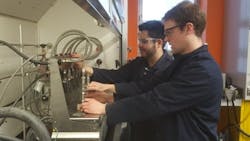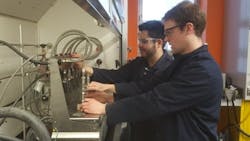Simpler Ketone Production Beckons
Canadian researchers are hoping to upend the conventional approach of using Friedel-Crafts reactions to make ketones. Improvements in the traditional method have occurred in recent years, for example to increase product selectivity — but intrinsic problems remain, not least in the need for high-energy reactive reagents that create significant chemical waste, note the researchers.
Figure 1. Gerardo Martin Torres (l) and Garrison Kinney are working on a carbonylation reaction that could transform the production of ketones. Source: McGill University.
To counter these, various transition-metal-catalyzed approaches have evolved over the last decade. While these use benign reagents and generate much less waste, their chemistry is complicated by the need for substrate activation and high catalyst concentrations.
Researchers in the department of chemistry, McGill University, Montreal, believe they have overcome these problems with a new reaction that uses broadly available and stable reagents — aryl halides, arenes and carbon monoxide — in a transformation that occurs in common solvents with low loadings of simple palladium catalysts.
The platform can serve to build potent acylating agents known as aroyl triflates.
“This approach could offer a new and green method to activate readily available but inert hydrocarbons, and use them to make a variety of valuable products,” says chemistry professor Bruce Arndtsen, who leads the research and is senior author of a recent article on the approach in Nature Chemistry.
“One of the goals we have over the next 1–2 years is to use carbon monoxide to create even-more-reactive organic electrophiles. This, we hope, would open the chemistry to using even-less-reactive substrates in carbonylation reactions — potentially even alkanes,” he notes.
Arndtsen believes such chemistry would be readily scalable for pharmaceutical-scale synthesis, provided the plant had the capability to work with carbon dioxide.
At the same time, the team is exploring how to remove the silver salt additive and aryl iodide substrates currently used in the reaction and instead simply use carbon monoxide and aromatic hydrocarbons. “Removing the expensive salt and aryl iodide reagents would likely be important for chemical-industry-scale processes, which is a longer-term goal,” he explains.
During the course of the study, the team briefly probed if their method could be used to build up even-more-reactive electrophiles known as aroyl triflimades. While very little is known of these chemicals in this context, their potential is clear.
“The aroyl triflimides are intriguing for their higher reactivity and greater selectivity. One challenge beyond the triflate work is that they are less stable — hence their reactivity — so more-active catalysts would be needed. Then, they could be created under milder conditions than triflates and be exploited more broadly in bond functionalization,” he adds.

